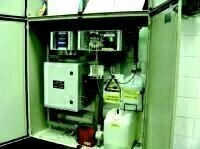Water/wastewater
Diverse Range of Water Monitors Enables Costeffective Compliance for the Paper and Board Industry
Jan 01 2000
European consent conditions for discharge to controlled waters are becoming ever more stringent, with the risk of legal proceedings for continued consent failure. ATi’s monitors provide dependable and accurate results, helping paper manufacturers to easily and quickly comply with these rules.
ATi supplies a range of gas and water monitors for a variety of applications, and is fast becoming the de facto company for chlorine monitoring. The measurement of chlorine in wastewater effluent in the paper industry is often carried out using strongly reducing sulphur compounds, thereby eliminating toxic chlorine residuals. According to EU regulations, residual chlorine discharge limits should be little above zero, meaning that the measurement of residual values is very difficult. With many conventional chlorine monitors, controlling residuals at values between zero and a few hundred partsperbillion is often not achievable. ATI’s A15/66 residual sulphite monitor allows continuous measurement of sulphite residuals over ranges of either 02 or 020PPM while reducing chemical expense to a minimum. With the A15/66 system, the sensor never comes in contact with the wastewater sample, resulting in a system that will continue to function regardless of the quality of the effluent, making the monitor invulnerable to fouling.
The disposal of dissolved hydrogen sulphide in public sewers is strictly regulated by the Environment Agency and water companies through the granting of consent to discharge. Many paper mills have wastewater consent to discharge level of 1.00ppm of dissolved hydrogen sulphide. The A15/81 dissolved hydrogen monitor from ATi is the only instrument available on the market capable of achieving continuous, precise, sensitive and direct measurements of true dissolved hydrogen sulphide levels in water. ATi’s A15/81 monitor removes the need to analyse samples in a laboratory by enabling sampling at any point in the wastewater process, while also requiring very little maintenance due to noncontact gas phase measurement.
Turbidity measurement is often necessary as part of the discharge monitoring from paper and board manufacturers, as sensor fouling can be a major problem. Turbidity is a general indicator of the optical clarity of water and is defined as the amount of light scattered from particles in solution. ATI’s D15/76 autoclean turbidity monitor is designed to meet the needs of industrial water treatment for reliable, lowrange turbidity measurements. With an “airblast†cleaning system that automatically cleans the sensor as often as necessary, the D15/76 completely eliminates sensor fouling and maintains reliable measurements of turbidity in wastewater.
Mike Strahand, General Manager Europe at ATi, comments: “Analytical Technology is committed to developing and improving the sensing technologies that help ensure the quality of the environment in which we live and work. Our sensors are at work 24 hours a day, 365 days a year, year after year, improving the control of potable water and wastewater treatment and helping paper and board manufacturers comply with the strict regulations. Our innovative methodology is set to revolutionise the way effluent treatment is processed.â€
Digital Edition
IET 35.2 March
April 2025
Air Monitoring - Probe Sampling in Hazardous Areas Under Extreme Conditions - New, Game-Changing Sensor for Methane Emissions - Blue Sky Thinking: a 50-year Retrospective on Technological Prog...
View all digital editions
Events
May 06 2025 Nuremberg, Germany
May 10 2025 Karachi, Pakistan
May 11 2025 Vienna, Austria
May 11 2025 Seoul, South Korea
Salon Analyse Industrielle & Instrumentation
May 14 2025 Paris, France


.jpg)



.jpg)


_(4427399123)-(2).jpg)









